
Whether you are a business owner or a content creator, understanding the fundamentals of SEO is essential to driving organic traffic to your website. In this beginner’s guide, we will break down the basics of SEO and provide you with a solid foundation to build upon.
Search engine optimisation is all about helping users discover your website amongst the huge amount of information online.
This SEO guide empowers beginners and website owners to:
- Grasp core SEO principles like keyword research and content creation.
- Understand search engine ranking mechanisms.
- Craft user-friendly websites and high-quality content.
- Analyse SEO performance with key metrics and tools.
Go beyond the basics with advanced strategies to solidify brand authority and achieve long-term SEO success.
What is SEO?
Search Engine Optimization is the practice of improving your website’s visibility and ranking on search engine result pages (SERPs). By optimising your website, you increase the chances of appearing higher in organic search results, ultimately driving more traffic to your site.
Importance of SEO for Websites
A well-optimized website extends its reach, achieves higher visibility in the online space, and engages more effectively with its intended audience.
SEO isn’t just about appealing to search engines; it’s also about connecting with people at the exact moment they are seeking what you offer. With most online experiences beginning with a search engine, your website’s presence in top search results is crucial for tapping into your audience’s intent and driving relevant traffic to your site.
Why is SEO crucial for online success?
The digital marketplace is immensely competitive, and SEO is the tool that can give businesses the edge they need. SEO is crucial for online success for several compelling reasons:
- Visibility and Ranking: With studies indicating that a staggering 75% of users never scroll past the first page of search engine results, the importance of ranking higher becomes clear. Being featured on the first page is pivotal—it’s the difference between being a market leader and being overlooked.
- Credibility and Trust: A key benefit of ranking higher on search results is the vote of confidence it implies. Users typically associate higher rankings with credibility and authority, thereby trusting these sites to offer value.
- Quality Traffic: SEO isn’t just about quantity—it’s also about quality. Attracting visitors actively searching for products or services you provide translates to a higher likelihood of engagement and conversion.
- Cost-Effectiveness: Compared to paid advertising, SEO delivers sustained organic growth. While it requires upfront investment, the long-term benefits include reduced costs per acquisition and a better ROI.
- Informed Strategy: Tools like Google Analytics offer insights into SEO performance, helping businesses understand customer behaviour, refine their strategies, and make data-driven decisions.
Understanding Search Engine Optimisation
The objective of SEO is to enhance a site’s quality and quantity of website traffic, as well as brand exposure, through organic search results. Unlike paid advertising, SEO involves making changes and optimisations to your website to make it more attractive to search engines. Effective SEO can lead to a higher rank in SERPs for relevant keywords, making it a fundamental aspect of digital marketing.
Crawling and Indexing
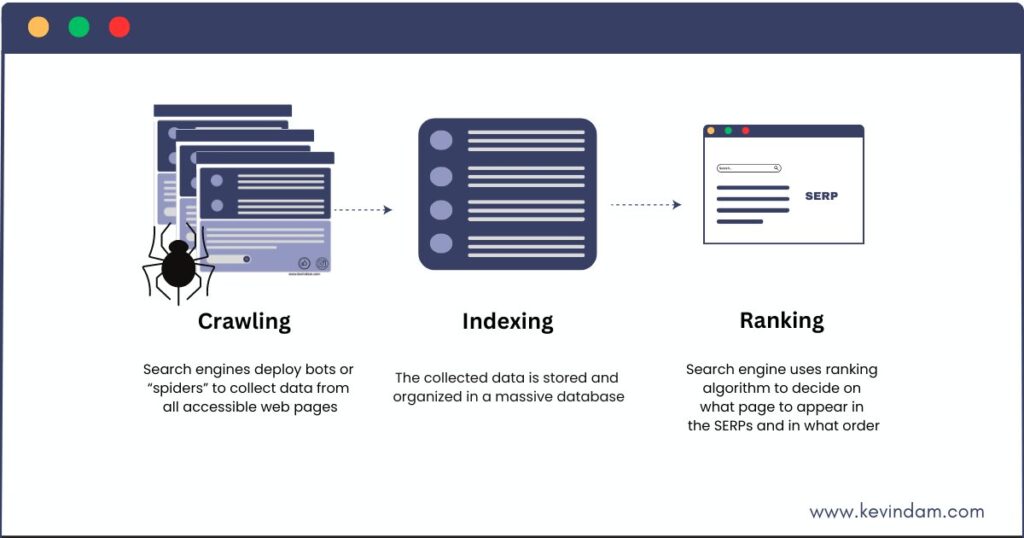
Search engines utilise automated robots, commonly known as bots or “spiders,” to perform indexing and crawling. Crawling is the initial step where these robots traverse the web to collect data from all accessible webpages. Then comes indexing, a process where the collected data is stored and organised in a massive database.
Think of it as the index at the back of your favourite book – all important keywords are bored down so the book can be easily found when you look up something specific
Once a webpage is indexed, search engines use sophisticated algorithms to evaluate and rank web pages based on a multitude of factors, including relevancy, authority, and user experience.
- Relevancy refers to how well a webpage meets the needs of the person searching. If someone looks for “best pizza places”, a page talking about “pizza toppings” might be related but not very relevant compared to one with lists and reviews of actual pizza restaurants.
- Authority is about trust, like how you trust experts more than someone who just started learning yesterday. Websites with many other websites linking to them show that they might know what they’re talking about.
- User experience considers things like how fast a webpage loads, if it works well on mobile devices, or if it’s secure. After all, nobody wants to wait forever for a page to load or worry if their personal information is safe while browsing.
SEO Fundamentals
SEO Fundamentals involve optimising various facets of your website so it can achieve better visibility. In this section, we will break down different aspects of SEO and explain how they contribute to improving your website’s visibility:
Keyword Research: Finding Relevant Keywords for Your Website
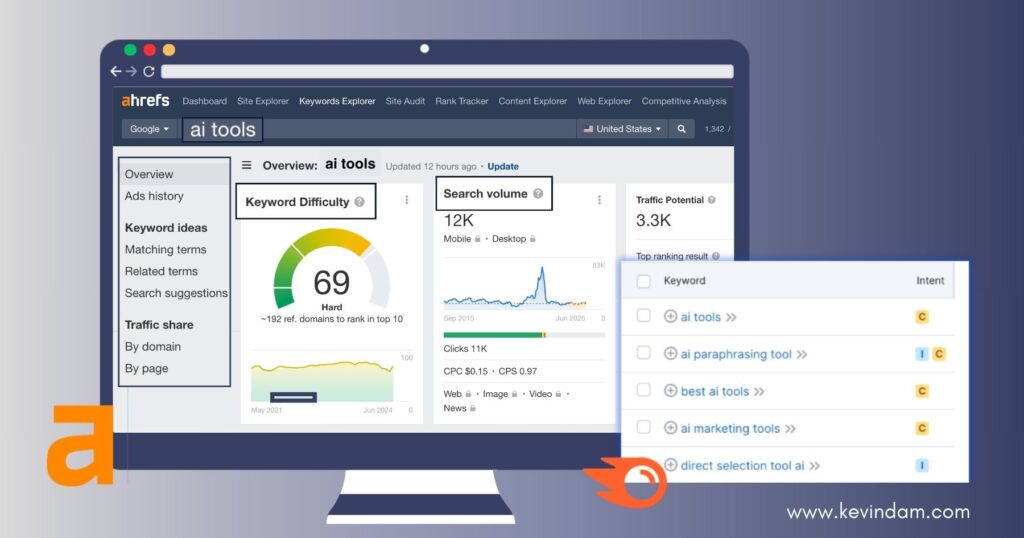
Keyword research is the cornerstone of an effective SEO strategy. Selecting the right keywords to target is vital for ensuring that your content aligns with what your audience is searching for.
SEO tools like Ahrefs and SEMrush offer insights into search volume, keyword difficulty, and what your competitors are ranking for. By utilising these keyword research tools, you can identify relevant keywords with a substantial search volume but may not be overly saturated with competition, giving your website a competitive edge.
There are several factors to consider when doing keyword research:
- Search volume: This refers to the number of times a keyword is searched for in a given time period. You want to target keywords with a higher search volume to ensure your content reaches as many potential visitors as possible.
- Keyword difficulty: This metric evaluates how easy or difficult it will be to rank for a specific keyword. Keywords with high difficulty may have a lot of competition and require more effort to rank well. It is advisable to target a mix of high and low-difficulty keywords to maximise your chances of ranking.
- Relevance: Your chosen keywords should be highly relevant to your website’s content and the needs of your target audience. By targeting relevant keywords, you can attract the right visitors who are more likely to engage with your content and convert it into customers.
- Search Intent: Search intent refers to the underlying purpose or motivation behind a user’s search query. There are generally four types of search intent:
Matching your content with the correct search intent ensures that users find exactly what they’re looking for on your website, which can lead to a higher rate of user satisfaction and engagement.
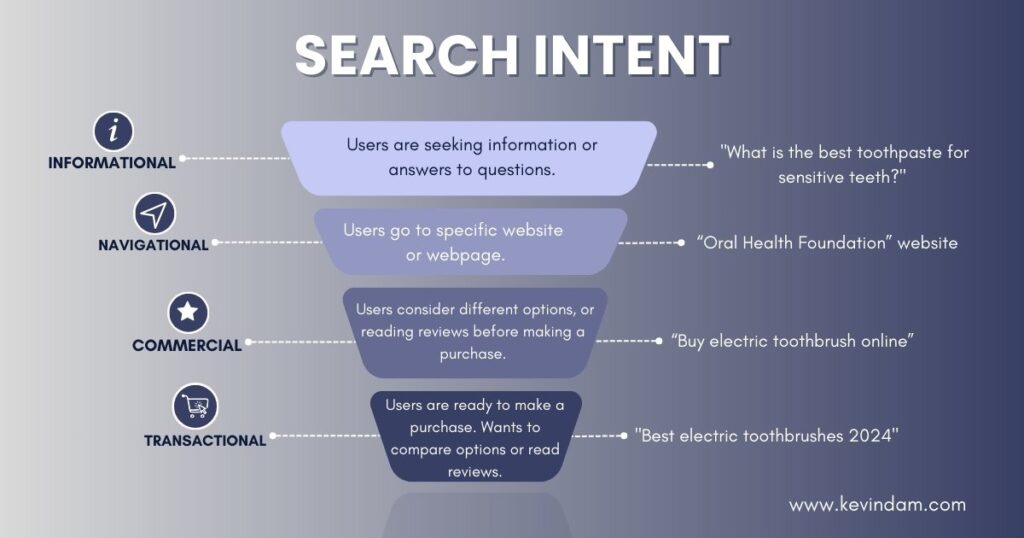
Here’s how understanding search intent benefits your keyword research:
- Improved Relevance: When you know the user’s intent, you can tailor your content to address their needs directly. This improves the relevance of your content to the search query, which is a key factor for Google ranking.
- Traffic Quality: By targeting keywords with the right intent, you attract users who are genuinely interested in what you offer. This leads to higher engagement, conversions, and a better return on your investment.
- Content Strategy: Understanding search intent helps you develop a comprehensive content strategy. You can create a mix of informative blog posts, buying guides, and product pages to target users at different stages of the buying journey
Once you have identified your target keywords, incorporate them strategically into your website’s metadata, headers, content, and URLs. However, it’s important to remember not to overstuff your content with keywords, as it can lead to penalisation from search engines
Creating High-Quality Content
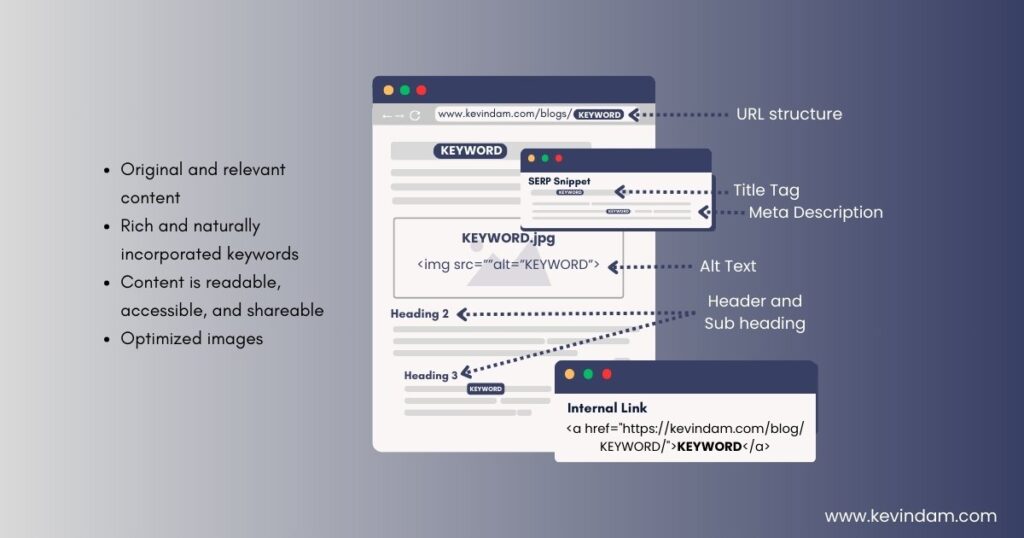
The creation of high-quality content goes beyond simply putting words on a page. It involves strategic planning, a deep understanding of one’s audience, and the ability to engage readers with valuable information.
Consider these key points when optimising your content:
- Craft original and relevant content that provides value. Search engines favour fresh, informative, and unique content that satisfies users’ search queries.
- Identify and incorporate strategic keywords into your content to improve its visibility in search engines, but ensure that it reads naturally and isn’t overused to avoid keyword stuffing.
- Pay attention to meta titles, descriptions, and header tags to ensure they are optimised for search engines.
Moreover, ensuring your content is readable, accessible, and shareable will help extend its reach and impact. This means paying attention to layout, bullet points, and images to break up text and make your content more digestible.
Importance of compelling and shareable content
Compelling content is the kind that captures attention, retains interest, and encourages sharing. To amplify the reach and impact of content, it often has to be more than just text. Incorporating multimedia elements such as engaging videos, informative infographics, and eye-catching images can significantly boost a content piece’s appeal.
When content is shareable, it naturally earns additional backlinks and social signals, both of which are favourable in the eyes of search engines and can increase organic traffic.
The quality of content should always be a top priority. It’s not just about quantity but also about the value that your content provides to the readers. When your content is informative, interesting, and unique, it has a better chance of ranking well in SERPs.
Long-form content and pillar pages
Long-form content and pillar pages are essential components of a successful content strategy for SEO. Long-form content is typically between 1,000 and 7,500 words and provides in-depth information on a specific topic. This type of content is beneficial because it has a higher chance of ranking for multiple keywords and addressing various relevant sub-topics within a broader theme.
Pillar pages, however, serve as the foundational piece of content that provides a general overview of a broad topic. These pages target broad keywords and act as the main hub for a content cluster strategy. Cluster content, which consists of supporting pages that delve into subtopics within the theme in detail, is then linked back to the pillar page.
By creating pillar pages and cluster content, you can organise your topics in a structured manner that covers all important keywords systematically. This not only provides more value for your readers by offering comprehensive information on a topic but also helps to increase your authority in those specific topics by interlinking closely related pages.
On-Page Optimization: Enhancing Your Website’s Content

On-page optimisation focuses on optimising the content on your website to make it more attractive to search engines and users. Here are a few key elements to consider:
- Content quality: Create high-quality, informative, and engaging content that provides value to your audience. Ensure that your content is well-researched, error-free, and formatted properly for readability.
- Title tags: Meta titles tell searchers what each page on our website is about—it’s important they are descriptive, concise, and attention-grabbing. Industry best practices suggest using targeted keywords near the beginning of meta titles (when it makes sense) in order to signal relevance to both search engines and users.
- Meta descriptions: Similarly, meta descriptions provide a small preview of what users can expect once they click through to our website. When writing meta descriptions, these are some ways to optimise them:
- Keep the characters below 160
- Include your primary keyword
- Your description should be meaningful and match your content
- Add a CTA if necessary
- Headers and subheadings: Use headers and subheadings to break up your content and make it easier for both users and search engines to navigate. Incorporate relevant keywords in your headers to improve the SEO of your page.
- URL structure: Create user-friendly URLs that are descriptive and include keywords. This helps search engines understand the content of your page make makes it easier for users to remember and share your URLs.
- Internal linking: Linking to other relevant pages within your website can help search engines discover and index your content. It also improves user experience by providing them with additional resources and information.
- Image optimisation: Optimize your images by compressing them for faster load times and using descriptive file names and alt tags. This helps search engines understand what the image is about and can drive additional traffic through image search.
Off-page SEO: Building High-quality Backlinks
Off-page SEO consists of actions taken outside of your own website to affect your rankings within SERPs. Creating a network of high-quality backlinks to your site is one of the most influential off-page SEO tactics. These backlinks act as endorsements of your content’s credibility and authority, which search engines reward with higher rankings.
To acquire these links, consider strategies such as guest blogging, social media engagement, influencer outreach, and getting your brand mentioned on authoritative sites.
When credible websites link to yours or when influential individuals endorse your brand on social media platforms, it signals to search engines that your website is trustworthy and authoritative in its niche.
Technical SEO and User Experience
Think of your website as a store. You want people to find it easily (SEO) and have a pleasant experience when they walk through the door (UX). That’s where user experience and technical SEO come together.
Technical SEO lays the foundation
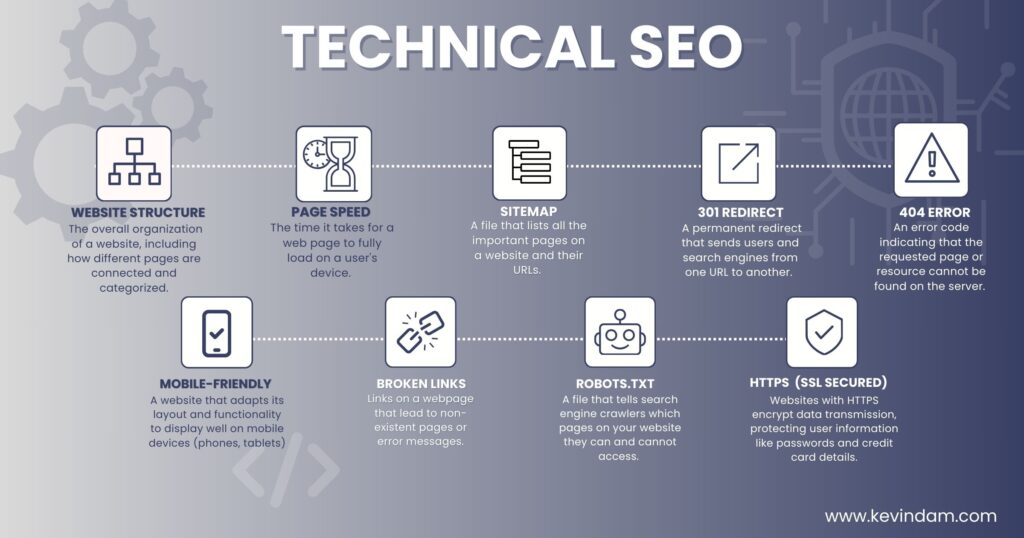
When it comes to ensuring that your website functions flawlessly on a mobile device, testing is important. All interactive features like forms, buttons, and dropdown menus must work just as smoothly on a mobile as they do on a desktop.
Here’s how to prioritise your mobile responsiveness testing efforts:
1. Focus on Core User Flows and Functionality:
- Identify the most critical functionalities and user journeys within your app or website. These could be actions like login, product purchase, or content search.
- Prioritise testing these core user flows across different screen sizes and device orientations – portrait and landscape.
2. Target Popular Devices and Browsers:
- While testing everything is ideal, resources might be limited. Focus on the most popular device and browser combinations used by your target audience.
- Analytics data can provide insights into these trends. Common choices include iPhones, Android devices, and popular browsers like Chrome and Safari.
3. Responsiveness of Visual Elements:
- Test how images, videos, and other visual elements adapt to different screen sizes. Ensure they don’t become blurry, pixelated, or overflow the screen.
- Verify proper alignment and responsiveness of text content. Fonts should be readable and sized appropriately for mobile viewing.
4. Prioritize User Interaction:
- Test the responsiveness of buttons, menus, and other interactive elements. These should be easily tappable and function as intended on mobile devices.
- Ensure proper hit areas for touch interactions, considering the limitations of finger-based navigation compared to mouse clicks.
5. Test for Performance:
- Mobile users are more likely to abandon slow-loading pages. Test website loading speed across different devices and network connections (WiFi vs cellular data).
- Consider image optimisation techniques and leverage caching mechanisms to improve mobile website performance.
Additional Tips:
- Utilise a combination of real device testing and emulators/simulators to gain a comprehensive understanding of responsiveness across various platforms.
- Accessibility should be a priority. Ensure your mobile interface adheres to accessibility guidelines for users with visual impairments or other disabilities.
There are tools available to help us assess the user-friendliness of our website on mobile devices. Utilising tools like Google’s Mobile-Friendly Test and PageSpeed Insights will give you a detailed report outlining the aspects that are functioning seamlessly and the areas that may require attention. These reports shed light on specific facets necessitating improvement to ensure an optimal user experience for those accessing our site via mobile.
By focusing on these key priorities, you can ensure your mobile responsiveness testing efforts deliver the most value. A well-tested and responsive mobile experience translates to a happy and engaged user base as people aere becoming more increasingly utilising mobile phones more than their desktops.
This aspect focuses on the technical aspects of your website, such as site speed, mobile optimisation, and site structure.
Loading speed
Ensure that your website loads quickly, as slow-loading sites can negatively impact user experience and SEO. To reduce loading times, optimise image sizes, leverage browser caching, reduce server response time, minimise the number of plugins, and consider using a content delivery network (CDN).
You can analyse your website’s loading speeds using tools like Google’s PageSpeed Insights to find specific areas that need improvement. Faster loading times can significantly reduce bounce rates and improve overall user retention and engagement, signalling to search engines that your website offers a quality experience.
Mobile Optimization
With most internet traffic coming from mobile devices, it’s essential to optimise your website for mobile. A mobile-optimized site should have the following characteristics:
- adjusts seamlessly to smaller screens
- provides easy navigation with touch-friendly buttons and menus
- simplifies the user journey to encourage longer dwell times and reduce frustration that could lead to high bounce rates
Google, in particular, has adopted mobile-first indexing, meaning it predominantly uses the mobile version of a site for ranking and indexing. To cater to this shift, webmasters must ensure that their sites offer an uncompromised user experience on smaller screens, which often includes streamlining design elements, optimising images for faster load times, and removing intrusive pop-ups that can harm the mobile user experience.
Site structure
Organise your website with a logical site structure to make it easy for users and search engines to navigate. Use a clear hierarchy of categories and subcategories, and create an XML sitemap to help search engines understand the structure of your site.
Addressing these technical SEO elements helps search engines navigate your site effectively, thereby increasing your content’s chances of ranking well.
User Experience keeps visitors engaged
User Experience (UX) refers to a person’s emotions and attitudes when using a particular product, system, or service, notably in the context of websites or applications. An excellent user experience is a cornerstone for driving engagement and improving the overall performance of a site in search engine rankings.
Websites that are intuitive, accessible, and enjoyable tend to hold visitors longer, prompting positive behaviour signals to search engines. Improved UX can lead to higher conversion rates, lower bounce rates, and greater organic reach, all significant factors that search engines consider when ranking sites.
Clear Navigation and Structure:
A simple and intuitive navigation system is crucial. A well-organized website allows users to find what they need without confusion, making their experience swift and satisfying. This clear structure is equally beneficial for search engine crawlers as it makes it easier to index your site’s content.
Content Usability: Technical SEO ensures your content is properly formatted and accessible, but UX looks at how easy it is to understand and engage with.
Here are some Formatting Considerations:
- Keep the paragraphs concise for better readability.
- Where appropriate, use lists or tables to present information in a more digestible format.
Analysing SEO Performance
To measure the success of your SEO efforts, it’s crucial to analyse performance using the right tools and metrics. This analysis helps you understand what strategies are working well and where you need improvement. Regular performance reviews can guide your ongoing SEO efforts, ensuring that your website continues to climb the ranks of search engine results pages (SERPs) and attract more organic traffic.
Utilising Google Analytics and Google Search Console for SEO Analysis
Google Analytics and Google Search Console are two powerful tools you can use to gauge the success of your SEO campaign. Google Analytics provides insight into the behaviour of users on your site, helping you understand the flow of traffic, demographics, device usage, and much more. It also tracks conversion rates, helping you to see which pages are most effective at converting visitors into customers or leads.
On the other hand, Google Search Console focuses more on the visibility and health of your site in Google’s search results. It helps you find and fix technical errors, submit sitemaps, see which search queries bring users to your site, and understand your site’s impression and click-through rates (CTR).
Together, these tools give you a comprehensive view of your SEO performance and allow you to make data-driven decisions to improve your search rankings.
Understanding SEO Analytics and Metrics
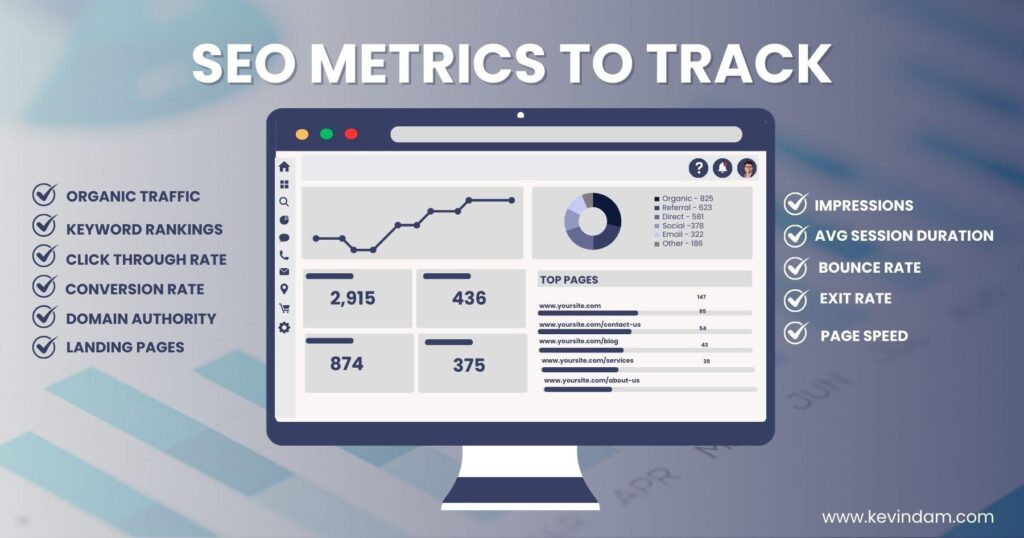
To effectively analyse SEO performance, you need to be familiar with key metrics. Some important analytics to track include:
- Keyword Rankings: This metric tells you where your pages rank in the SERPs for specific keywords. High rankings can lead to more visibility and organic traffic.
- Backlink Analysis: Evaluating the quality and quantity of links pointing to your site can inform you about your domain authority and reveal link-building opportunities.
- Conversion Rate: This measures the percentage of visitors completing a desired action, showing the effectiveness of your site in turning visitors into customers.
- Bounce Rate: The rate at which visitors leave your site after viewing only one page. A high bounce rate could indicate that your content is not engaging or relevant to your audience.
Analysing these metrics over time will allow you to see trends and measure the impact of the adjustments to your SEO strategy.
Measuring Conversion Rates and Bounce Rates
While conversion rates and bounce rates are critical metrics to track, don’t overlook other valuable analytics such as:
- Average Session Duration: How long users spend on your site can indicate engagement and interest in your content.
- Pages Per Session: The average number of pages visited during a session. More pages can indicate higher engagement.
- Organic Traffic: The total number of visitors coming to your site directly from search engines.
To analyse this data, consider creating a table showing the correlation between page load times and bounce rates or a list outlining steps to improve conversion rates, such as optimising calls-to-action or refining your target keyword selection.
Remember, a comprehensive understanding and continuous monitoring of these metrics are indispensable for refining your SEO strategies and achieving lasting success in organic search performance.
Advanced SEO Strategies
When venturing beyond SEO basics, you must grasp advanced strategies to take your site’s visibility to the next level. Advanced SEO encompasses a broader set of techniques, tailor-made to align with search engine algorithms and user experience improvements. These strategies involve deeper analysis and more sophisticated implementation that targets not just quantity but the quality of organic traffic. And leverages the nuances of how search engines understand and prioritise content.
Advanced link-building techniques to improve search rankings
Ultimate success in SEO often hinges on a strong backlink profile. Advanced link building extends beyond simple directory submissions or basic outreach. Valuable techniques include:
- Broken Link Building: Identify broken links on relevant websites and offer your own content to replace webmasters.
- Skyscraper Technique:
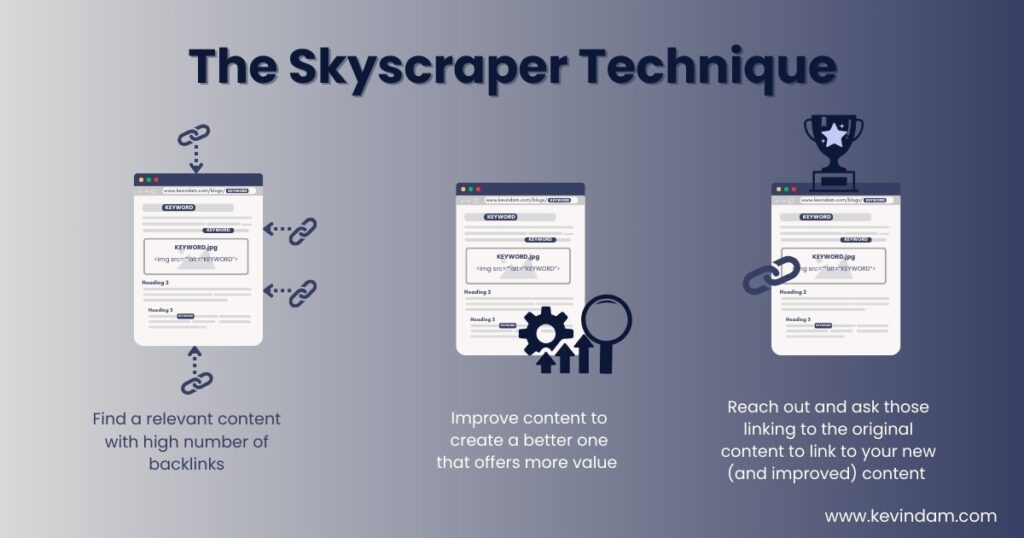
Find top-ranking content for your target keyword, create something even better, and then reach out to those who linked to the original, suggesting they link to your superior piece.
- Unlinked Brand Mentions: Search for instances where your brand is mentioned online but not linked, and request the site owner add a link to your site.
Remember, the goal is not just to increase the number of backlinks but to ensure these links are high in quality and relevance. Employing these techniques can significantly bolster your site’s authority and improve its standing on SERPs.
Conclusion
In conclusion, understanding the basics of SEO is crucial for beginners looking to improve their website’s visibility on search engine results pages. By implementing on-page and off-page optimisation strategies, conducting keyword research, and monitoring key performance metrics, you can lay a strong foundation for effective SEO.